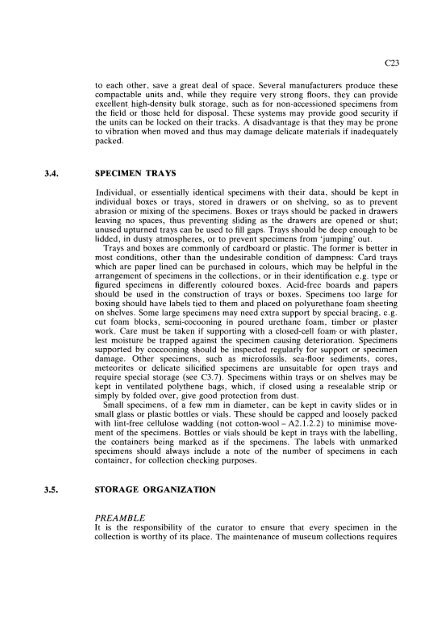GUIDELINES FOR THE CURATION OF GEOLOGICAL MATERIALS
GUIDELINES FOR THE CURATION OF GEOLOGICAL MATERIALS
GUIDELINES FOR THE CURATION OF GEOLOGICAL MATERIALS
Create successful ePaper yourself
Turn your PDF publications into a flip-book with our unique Google optimized e-Paper software.
to each other, save a great deal of space. Several manufacturers produce these<br />
compactable units and, while they require very strong floors, they can provide<br />
excellent. high-density bulk storage, such as for non-accessioned specimens from<br />
the field or those held for disposal. These systems may provide good security if<br />
the units can be locked on their tracks. A disadvantage is that they may be prone<br />
to vibration when moved and thus may damage delicate materials if inadequately<br />
packed.<br />
3.4. SPECIMEN TRAYS<br />
Individual, or essentially identical specimens with their data, should be kept in<br />
individual boxes or trays, stored in drawers or on shelving, so as to prevent<br />
abrasion or mixing of the specimens. Boxes or trays should be packed in drawers<br />
leaving no spaces, thus preventing sliding as the drawers are opened or shut;<br />
unused upturned trays can be used to fill gaps. Trays should be deep enough to be<br />
lidded, in dusty atmospheres, or to prevent specimens from 'jumping' out.<br />
Trays and boxes are commonly of cardboard or plastic. The former is better in<br />
most conditions, other than the undesirable condition of dampness: Card trays<br />
which are paper lined can be purchased in colours, which may be helpful in the<br />
arrangement of specimens in the collections, or in their identification e.g. type or<br />
figured specimens in differently coloured boxes. Acid-free boards and papers<br />
should be used in the construction of trays or boxes. Specimens too large for<br />
boxing should have labels tied to them and placed on polyurethane foam sheeting<br />
on shelves. Some large specimens may need extra support by special bracing, e.g.<br />
cut foam blocks, semi-cocooning in poured urethane foam, timber or plaster<br />
work. Care must be taken if supporting with a closed-cell foam. or with plaster,<br />
lest moisture be trapped against the specimen causing deterioration. Specimens<br />
supported by coccooning should be inspected regularly for support or specimen<br />
damage. Other specimens, such as microfossils, sea-floor sediments, cores,<br />
meteorites or delicate silicified specimens are unsuitable for open trays and<br />
require special storage (see C3.7). Specimens within trays or on shelves may be<br />
kept in ventilated polythene bags, which, if closed using a resealable strip or<br />
simply by folded over, give good protection from dust.<br />
Small specimens, of a few mm in diameter, can be kept in cavity slides or in<br />
small glass or plastic bottles or vials. These should be capped and loosely packed<br />
with lint-free cellulose wadding (not cotton-wool - A2.1.2.2) to minimise movement<br />
of the specimens. Bottles or vials should be kept in trays with the labelling,<br />
the containers being marked as if the specimens. The labels with unmarked<br />
specimens should always include a note of the number of specimens in each<br />
container, for collection checking purposes.<br />
STORAGE ORGANIZATION<br />
PREAMBLE<br />
It is the responsibility of the curator to ensure that every specimen in the<br />
collection is worthy of its place. The maintenance of museum collections requires

















